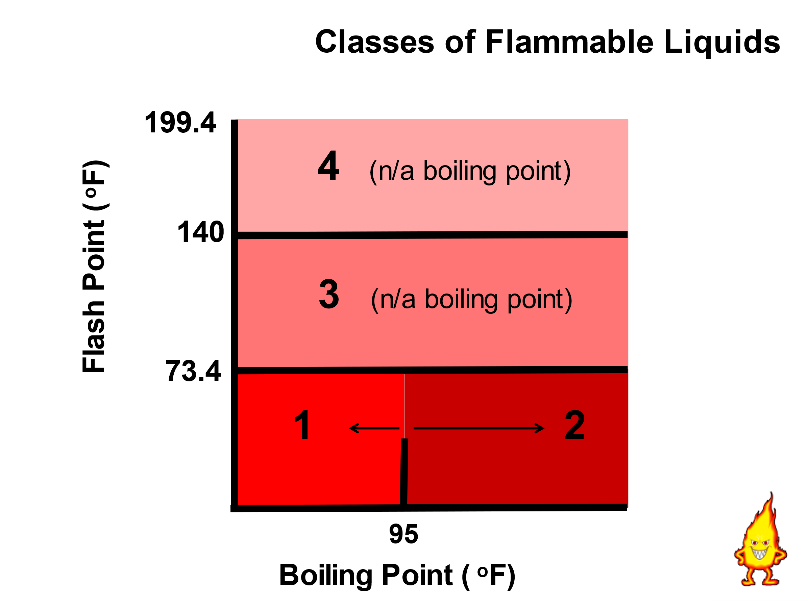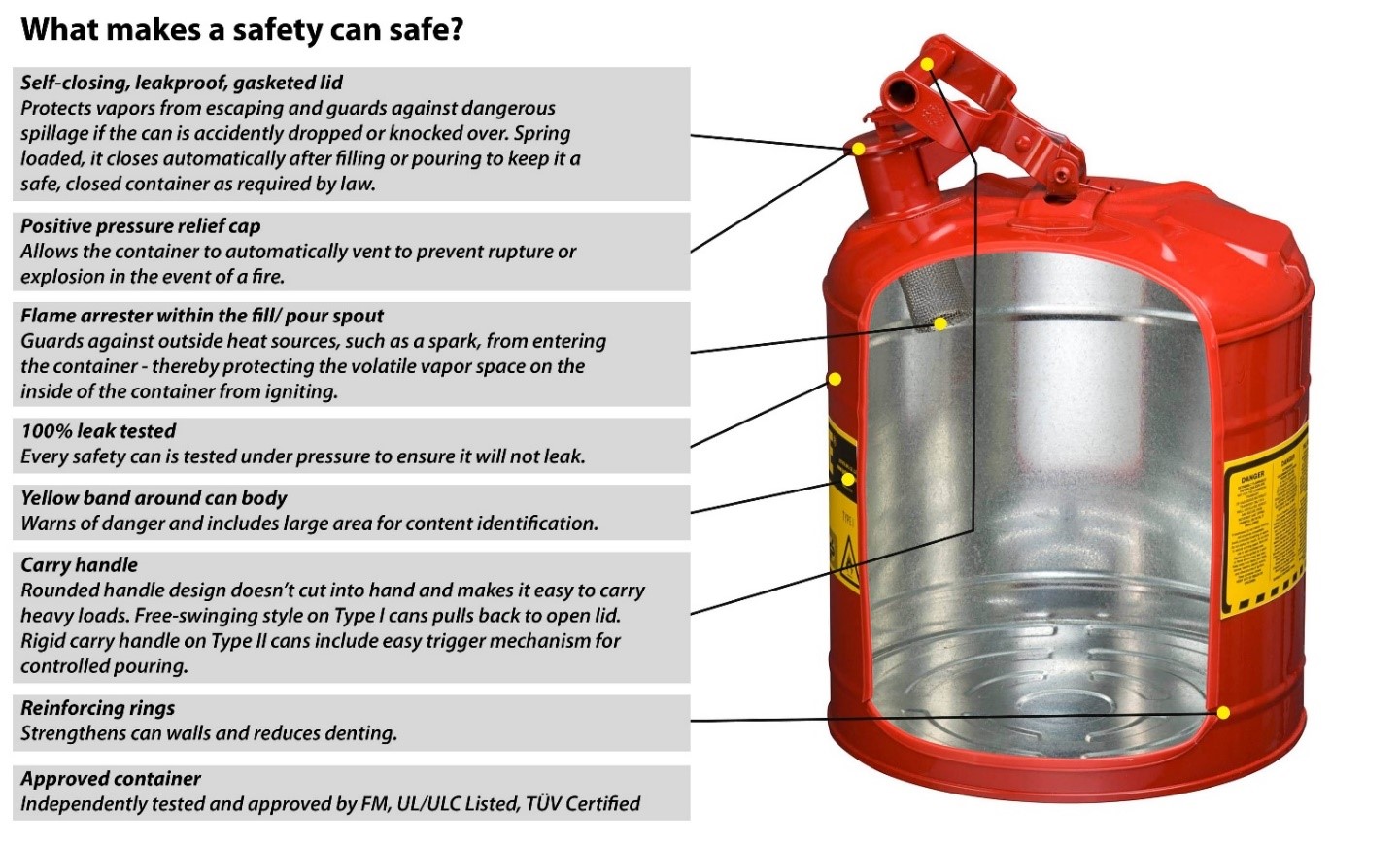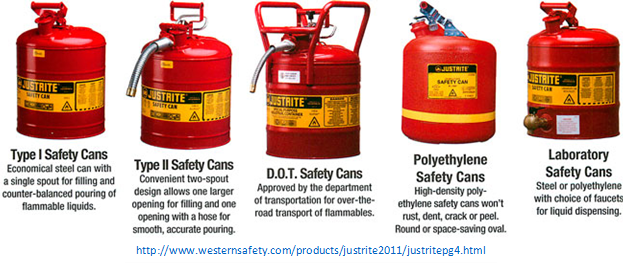Share This Article:
Gasoline storage questions are among the most common we hear. As a flammable liquid it is essential that businesses understand the requirements and best practices surrounding its storage and handling. This post will answer some of the most burning questions.
Q: “We occasionally use tools and equipment that require gasoline - How do businesses safely store small amounts of gasoline?”
A: To answer this question we need to understand the type of flammable liquid being used as well as the OSHA definitions and requirements for storage at a business versus at home.
Definition:
Flammable Liquid (per OSHA 1910.106): A liquid with a flashpoint at or below 199.4° F. (93° C). The National Fire Protection Association (NFPA) defines flammables slightly differently; nevertheless, OSHA standards are most often forefront in our readers’ minds. Flashpoint is the temperature at which a flammable liquid will give off sufficient vapor to ignite. Flammable liquids are subdivided into 4 Categories. Since gasoline has a flashpoint of well under 0°F it is a Class 1 Flammable:

STORAGE
There are differences between an Environmental Protection Agency (EPA) spill proof gasoline container for home use and a safety can that is required by OSHA and NFPA for commercial use. Most hardware and retail stores do not stock safety cans but sell the inexpensive cans which only meet EPA and other agency spill proof requirements. The EPA and spill proof regulations alone will not meet the safety can requirements but will allow flammable liquid storage for non-commercial use.
For commercial use a safety can is required, and the maximum container size is 5 gallons.Here are the six elements of construction that must exist to allow approval by OSHA or NFPA as a safety can:
- Be not more than 5 gallons in capacity.
- Be listed by a national testing lab such as UL, Factory Mutual, etc.
- Have a spring closing lid which closes after filling or pouring.
- Be leak tight.
- Have a flame arrestor screen.
- Have a safety valve to relieve internal pressure.
OSHA 1910.106(a)(29)

(photo credit ) https://www.justrite.com/news/safety-cans-flammable-liquid-storage-requirements/
All gas containers used should be approved by a nationally recognized testing agency such as Underwriters’ Laboratories (UL) or Factory Mutual Engineering Corp (FM).
These are the common markings found on flammable liquid containers:
- FM - FM Global tested and approved
- UL - Underwriters Laboratories listed
- ULC – Underwriters Laboratories - Canada
- N - Designed in accordance with National Fire Protection Association (NFPA) code 30 regulations
- O - Complies with OSHA regulations
- U - Complies with either the International Fire Code of NFPA 1 Uniform Fire Code
- SPCC - Spill Prevention Control and Countermeasures compliant
There is a common misconception that safety cans must be metal. They now manufacture polyethylene safety cans that won’t rust, dent, crack, or peel like many metal cans do after long periods of storing fuels.

Q: How much gasoline can I have on hand at my business?
A: This depends on where the gasoline is stored at the workplace and if you use a flammable storage cabinet. OSHA (29 CFR 1910.106) has established the following storage practices to ensure flammable liquids are not stored in excessive quantities. If not using a flammable storage cabinet, no more than 25 gallons; however up to 60 gallons can be stored inside a flammable storage cabinet.
|
Maximum QuantitiesOutsideof a Flammable Storage Cabinet or Inside Storage Room |
|
|
Category and Container Type |
Quantity |
|
Category I Liquids in Containers |
25 Gallons |
|
Category 2, 3, or 4 Liquids in Containers |
120 Gallons |
|
Maximum QuantitiesInsideof a Flammable Storage Cabinet or Inside Storage Room |
|
|
Category of Liquid |
Quantity |
|
Category 1, 2, or 3 |
60 Gallons |
|
Category 4 |
120 Gallons |
In summary, gasoline is a category 1 flammable liquid which should be stored in a safety can. No more than 25 gallons should be stored outside of a flammable storage cabinet in commercial settings.
Gasoline is routinely handled by almost every adult in the U.S. However, the hazards associated with gasoline are often overlooked. The next time you fill up your car or put a few gallons of gas into a can take a minute to make sure you’re taking all the steps required to keep yourself safe.
By Natalie Campaneria and Hartley Webb
Courtesy of MEMIC
More by This Author
- Feb 10, 2025
- WorkersCompensation.com
- Oct 02, 2024
- WorkersCompensation.com
- Jun 24, 2024
- WorkersCompensation.com
Read More
- Mar 26, 2025
- Liz Carey
- Jan 30, 2025
- Liz Carey
- Aug 12, 2024
- Frank Ferreri
- Aug 06, 2024
- Frank Ferreri
- Aug 05, 2024
- Frank Ferreri




